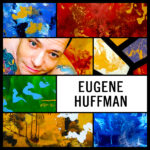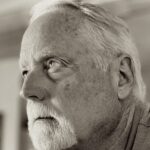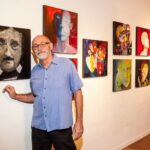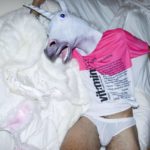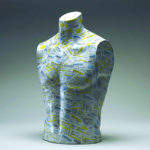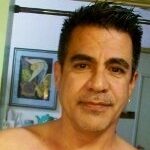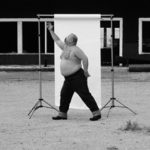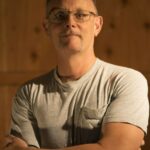POS•I•TIV•I•TY: A Conversation with Eugene Huffman, Visual AIDS Artist Member & Curator
Visual AIDS Artist Member, HIV Activist and Curator Eugene Huffman discusses the group exhibition POS•I•TIV•I•TY he curated in partnership with Art Share LA featuring Visual AIDS Los Angeles Artist Members George Dinhaupt, Kyle Kupres, Ed Lightner, Vasilios Papapitsios, Ryan Stanford and Joey Terrill; and San Diego Artist Members Rory Chrz, Patrick N Brown, David Jester, JP Schiteman and Patric Stillman with special guest Community Ally, Dominatrix and Performance Artist Bella Bathory. Below Visual AIDS Artist+ Registry & Archive Associate Tracy Fenix interviews Eugene Huffman about his collaboration with Visual AIDS Artist Members and their collective impact to share stories around positivity.
POS•I•TIV•I•TY is on view until November 3 at Art Share Los Angeles, CA. Gallery Hours: Wednesday- Sunday, 1-6PM
Tracy Fenix: How did you build and organize creative relationships with fellow Visual AIDS artists?
Eugene Huffman: A few of the artists I already had established working relationships with (Patric Stillman, Vasilios Papapitsios, Ryan Stanford), as I have curated shows in the past. For the remaining Visual AIDS artists, Alex Fialho was instrumental in helping me with those connections, and I reached out to them basically outlining my platform and what I was interested in doing, and if they were interested in the exhibition, to submit a bio and samples of recent work. Patric Stillman was a big help in organizing all of the artists in San Diego and getting their work to the gallery. From that point on its mainly being open and having open and honest communication. I have no doubt I will be working with many of these artists again.
TF: Why was it important to you to bring together this range of artists in this context?
EH: While Visual AIDS has a very impressive presence of HIV+ Artists in New York – having a bona fide presence here in the Los Angeles art scene is, I believe, a need and a necessity. While I’ve curated many shows that feature LGBT, Queer and Ally Artists, I noticed that there wasn’t a focus or much attention drawn to those living with HIV, and it gave me the inspiration to put something together. For a while I was working with an art coach – and this particular one “suggested” that I shouldn’t put being HIV+ as part of my identity, and that galleries would be more open to me if I just let that part fall into the background. After that day I ended the relationship. I’m sure there are many in the Los Angeles art scene that think the same thing, or have given other artists what they think is “advice”…when, really, all it is – is stigma. It’s fear. Not wanting to start a conversation or talk about HIV/AIDS. It’s still here. We are living with it. It’s important to our art and the work that we do – but it’s all too easy for gallerists and curators to push it aside, or brush it under the rug. Being HIV Positive - it’s part of our identity – it informs our art. It’s been in the background for far too long, and it should be front and center. It’s something to be embraced. In our LGBTQ and HIV/AIDS circles, it is often said that visibility matters – and it does – and that is no different when it comes to art.
TF: Given the wide range of artistic mediums present, how’d you conceptualize the exhibition?
EH: Each artist has their own unique and personal expression that make powerful statements. In reviewing all of the submissions I had, this was very prevalent. I was brainstorming ideas for the gallery name when I ran across the definition of positivity:
positivity:
the presence rather than absence of a certain substance, condition, or feature.
All of the artists have PRESENCE and SUBSTANCE. All of their works have a strong voice. And, of course, the definition also ties into living with HIV. It seemed like a perfect name and theme for the exhibition – and simplicity, I feel, is always the best approach
TF: How are you engaging themes of queer masculinity, intimacy, and vulnerability in this exhibition?
EH: If you look at all of the works of the artists in the exhibition, I really think those themes are very prevalent in all of their works, and spoken in different ways. Not to mention the fact that, being an artist, your vulnerability is there on display on the canvas or photograph you are showing – art is very personal, and you are putting your soul on display for everyone to see. It’s strength and vulnerability all at once. It’s also important to address the flip side of those themes – the one that comes to mind is toxic masculinity. I featured a community ally here, Bella Bathory, who is a lesbian dominatrix…and a couple of her pieces featured the negative things people – mostly men - have said about her written all over her body.
TF: How do you anticipate these connections to impact your artistic community and develop over time?
EH: My aim is to eventually acquire a permanent gallery and performance space that I can rotate artists and themes, but a space that’s dedicated to us. I also see many talented artists that create amazing work – but have never shown in a gallery, or don’t know how to get into the art world. Doing this exhibition also gave me time for reflection on how it turned out – I can do better in my representation and expand my outreach with self-identified trans communities, people of color and women. All of these are opportunities to reach out to make sure as many voices as possible, and different viewpoints, are represented in an exhibition. There are always ways to improve and do better.
This was also the first time a lot of the Visual AIDS artists met each other, or at least met other artists they didn’t know before. Positivity incites conversation, creates bonds, and ultimately – community. These are our opportunities to embrace and build on.
As a side note – our Opening Reception took place on the same night as the Opening Reception for the main gallery exhibit that was titled “Protest” – I loved seeing those people come and walk through our exhibition, and see art that they otherwise wouldn’t have seen, or necessarily sought out on their own. Each of those individuals spent a lot of time looking at the work on the walls and taking it in. I have to say, that was an absolute pleasure to witness. And when you first see the words Positivity and Protest together, you might not instantly think they are related – but they most definitely are. So there were extra connections made on a human level from that juxtaposition alone.
Special note from Eugene Huffman ***
I do want to give special thanks to Art Share LA. I’ve worked with them on curating a few exhibits before – and they were the ones that happily donated the gallery space to us to show these artists, and embraced the theme and topic wholeheartedly when presented with it. Without them (and of course – help from Visual AIDS), this exhibition wouldn’t have been possible.













